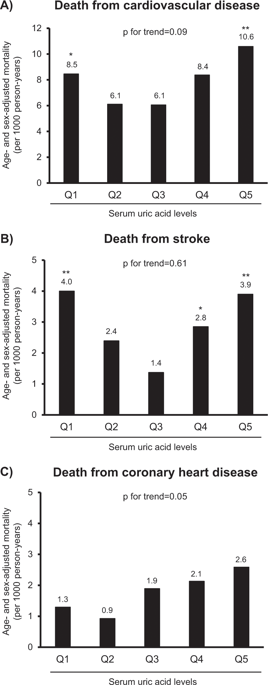Hypertension Research ( IF 4.3 ) Pub Date : 2020-01-17 , DOI: 10.1038/s41440-019-0390-8 Satoko Sakata 1, 2, 3 , Jun Hata 1, 2, 3 , Takanori Honda 1 , Yoichiro Hirakawa 1, 3 , Emi Oishi 1, 3 , Mao Shibata 1, 2 , Daigo Yoshida 1 , Kenichi Goto 3 , Takanari Kitazono 2, 3 , Toshiharu Ninomiya 1, 2

|
Studies on the association between serum uric acid levels and the risk of cardiovascular disease have yielded inconsistent results. We investigated the association of serum uric acid levels with cardiovascular disease mortality in a Japanese community. A total of 2633 community-dwelling Japanese people aged ≥40 years without a history of cardiovascular disease were followed up for 19 years. Serum uric acid levels were categorized into quintiles (Q1, lowest; Q5, highest). The hazard ratios for mortality from cardiovascular disease, stroke, and coronary heart disease were computed using a Cox proportional hazards model. During the follow-up, 235 subjects died from cardiovascular disease (including 84 from stroke and 53 from coronary heart disease). Risks for cardiovascular disease mortality were higher in both the Q1 and Q5 groups than in the Q3 group after adjustment for confounding factors (Q1, hazard ratio 1.50 [95% confidence interval 0.94–2.39]; Q2, 1.06 [0.66–1.72]; Q3, 1.00 [reference]; Q4, 1.44 [0.93–2.23]; and Q5, 1.89 [1.23–2.91]). A similar U-shaped association was observed for stroke mortality (Q1, 3.26 [1.29–8.25]; Q2, 2.21 [0.85–5.73]; Q3, 1.00 [reference]; Q4, 2.65 [1.07–6.58]; and Q5, 3.77 [1.54–9.24]), while coronary heart disease mortality was increased only in the Q5 group (Q1, 1.27 [0.46–3.50]; Q2, 0.85 [0.29–2.48]; Q3, 1.00 [reference]; Q4, 1.57 [0.63–3.92]; and Q5, 2.53 [1.03–6.18]). Elevated serum uric acid was suggested to be a significant risk factor for stroke or coronary heart disease mortality in a Japanese community. Conversely, the excess risk of stroke mortality in individuals with lower serum uric acid levels may indicate a possible cerebroprotective role of uric acid.
中文翻译:

日本普通人群的血清尿酸水平和心血管死亡率:久山研究
关于血清尿酸水平与心血管疾病风险之间关系的研究得出了不一致的结果。我们调查了日本社区中血清尿酸水平与心血管疾病死亡率的关系。对 2633 名年龄≥40 岁且无心血管病史的日本社区居民进行了为期 19 年的随访。血清尿酸水平分为五分位数(Q1,最低;Q5,最高)。使用 Cox 比例风险模型计算心血管疾病、中风和冠心病死亡率的风险比。随访期间,235名受试者死于心血管疾病(其中84名死于中风,53名死于冠心病)。调整混杂因素后,Q1 和 Q5 组的心血管疾病死亡率风险均高于 Q3 组(Q1,风险比 1.50 [95% 置信区间 0.94-2.39];Q2,1.06 [0.66-1.72];Q3 , 1.00 [参考];Q4, 1.44 [0.93–2.23];和 Q5, 1.89 [1.23–2.91])。在卒中死亡率方面观察到类似的 U 形关联(第一季度,3.26 [1.29–8.25];第二季度,2.21 [0.85–5.73];第三季度,1.00 [参考];第四季度,2.65 [1.07–6.58];和第五季度,3.77 [1.54–9.24]),而冠心病死亡率仅在 Q5 组增加(Q1, 1.27 [0.46–3.50]; Q2, 0.85 [0.29–2.48]; Q3, 1.00 [reference]; Q4, 1.57 [0.63] –3.92];和 Q5, 2.53 [1.03–6.18])。在日本社区,血清尿酸升高被认为是中风或冠心病死亡的重要危险因素。反过来,











































 京公网安备 11010802027423号
京公网安备 11010802027423号